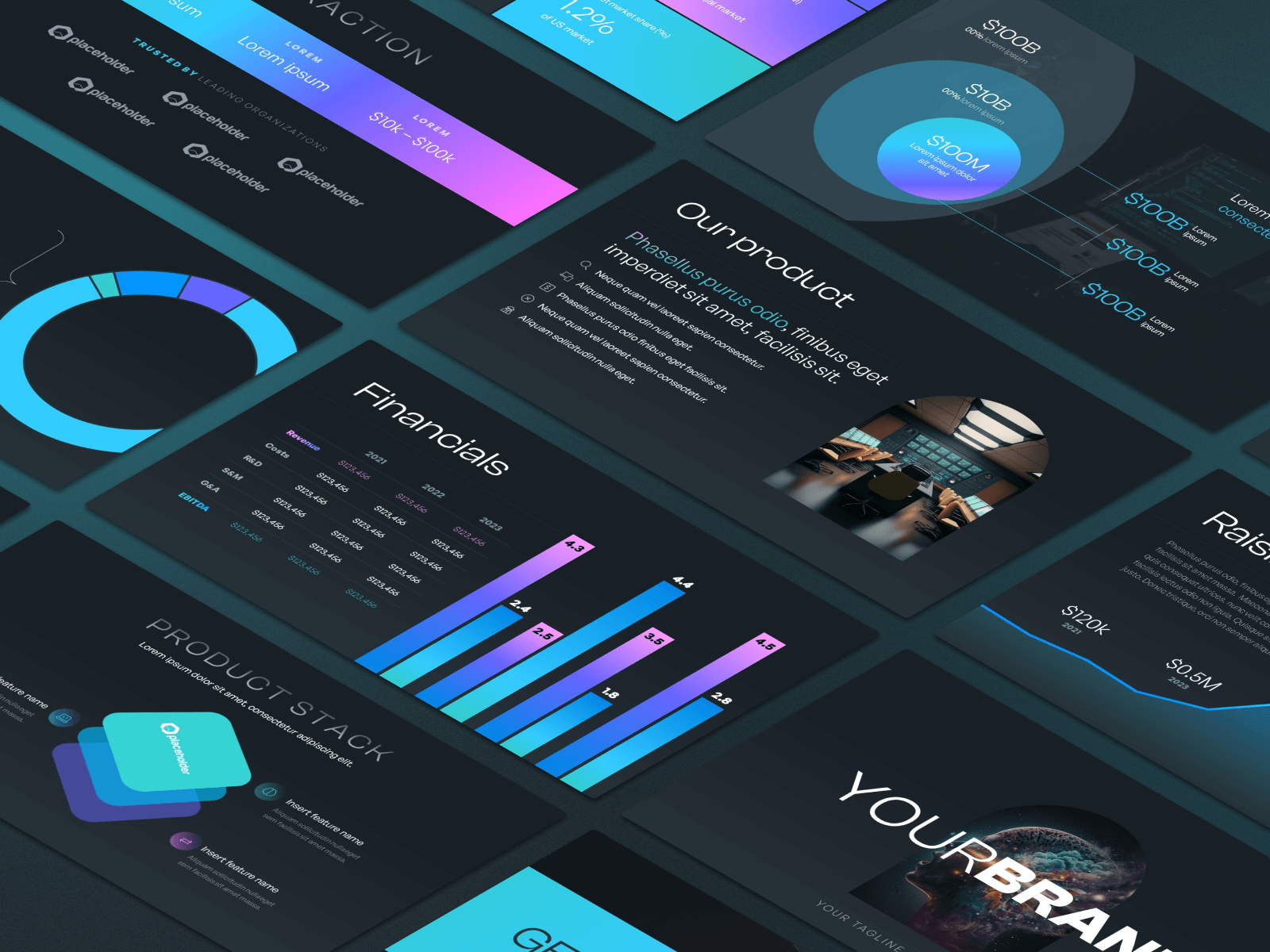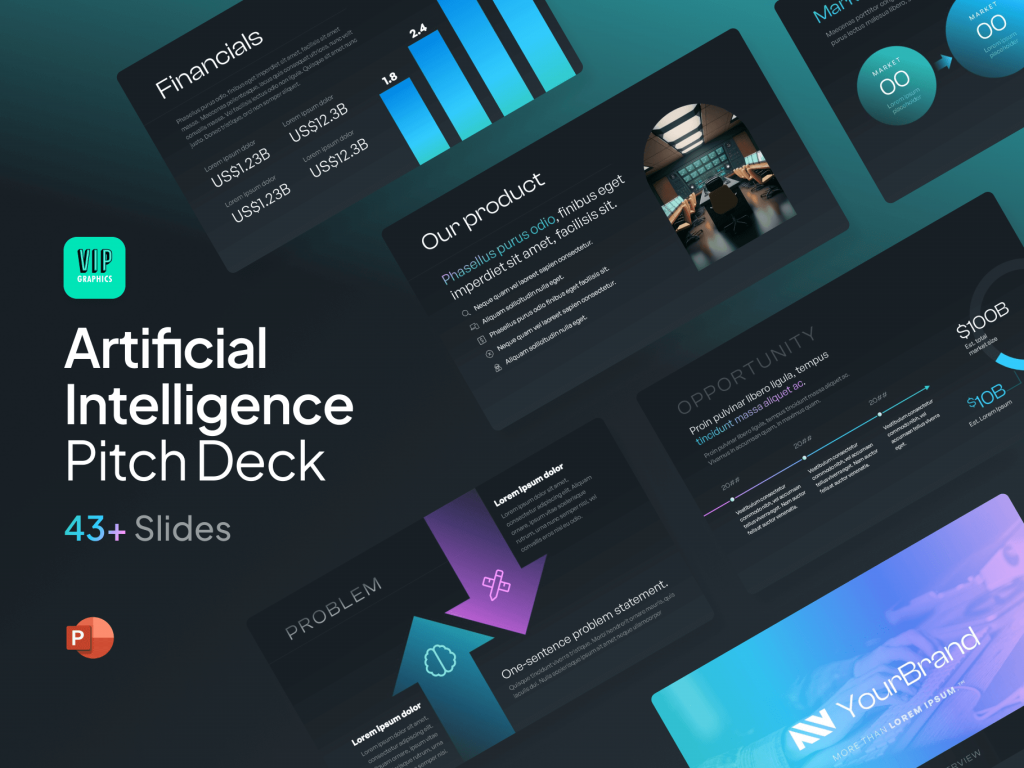As we step into a new year, the potential for artificial intelligence (AI) continues to soar — promising to be the start of the next big technological revolution. According to McKinsey, AI could potentially add $13 trillion to the global economy by 2030. While tools like ChatGPT and Midjourney have put the power AI at the fingertips of everyone with an Internet connection, startups like CopyAI and Macro have raised millions from blue-chip investors to build robust AI-powered tools. With such a promising outlook, entrepreneurs across industries (from restaurant automation to marketing software) are delving into the AI space.
Creating an effective pitch deck to win funding for your AI startup can be a daunting task, especially in such a competitive & fast-moving environment. This article aims to guide you through the process, sharing tips and tricks for crafting an attention-grabbing pitch deck for your AI startup that is sure to impress potential investors.
What is a pitch deck? What is its purpose?
A pitch deck is a presentation that startup founders generally use to win funding from investors. The goal of a pitch deck is to highlight the most important aspects of your startup (ie. the market, advantage, and team), so the audience can quickly grasp the opportunity your startup is tackling.
Aside from the obvious reasons, here’s why creating a pitch deck is so important for startups:
- Helps you quickly and clearly explain the value proposition of your startup
- Forces you to distill your ideas and important points into a clear and compelling framework,
- Enhances your business strategy and messaging
- Assists you to network and recruit partners, clients, and team members and raise funds.
A pitch deck conveys the value of your idea, shows your knowledge of the market and competitors, and emphasizes opportunity for growth and profitability in order to persuade investors to back your startup.
What slides should be in your AI startup’s pitch deck?
Ready to take your artificial intelligence startup to the next level with venture funding? Whether you want to attract investors or impress potential customers, learning from this guide is the perfect way to craft a winning pitch deck:
Cover Slide
Many founders overlook that the cover slide can make or break investment pitches, given it is your first impression. A cover slide must be both attractive and compelling. The goal is to capture the essence of your startup and communicate it in a way that’s both concise and compelling. Your startup’s tagline, logo, and name should be featured on your cover slide.
Problem and Solution Slide
Highlighting the problems faced by your target market and how your AI-driven solution may help to solve them is the goal of the problem and solution slide.
This slide should also highlight the key features of your product and how they apply to the issue you just described. Avoid focusing too much on the technical details (ie. the APIs or infrastructure) and focus on the benefits and unique value proposition that your solution offers.
Explain the benefits your product offers and how it operates in terms that your target market may easily understand. Be sure to back up your claims about the problem’s gravity and the value of your offering with evidence.
“How It Works” Slide
The “How It Works” slide is where you can highlight the more technical aspects of your product. Avoiding technical jargon and instead relying on visual aids like flowcharts and diagrams to describe how your product works is essential to avoid boring investors. Even non-technical audiences will want to understand how your product works — make it easy for them to do so.
Competitive Advantage / Differentiation Slide
Highlight the unique advantages and superior features of your solution compared to the alternatives already on the market on the competitive advantage slide. Don’t shy away from anticipating their questions and worries about the market and competition: make a strong case for why customers will prefer your offerings to incumbents. If you’re able to convey a clear competitive advantage, you’ll be one step closer to sealing the deal.
Market / Opportunity Slide
The market/opportunity slide should highlight the size and growth of the market that your startup serves. Avoid discussing broad strokes (ie. “X industry will reach $## billion by 202#”) — instead, zero in on specifics that pertain to your product and audience. Instead of generalizing about the size of the AI market, be precise about the size of the niche you serve. Don’t forget to back up your claims with credible sources and showcase how you plan to capitalize on a growing & ever-changing landscape!
Applications / Target Users
The application slide is crucial for demonstrating how well your solution fulfils the requirements of your target market. For some startups, this slide will speak to the target customer segments and ideal customer persona (ICP) for your solution (ie. demographics or industry verticals), whereas others will focus on specific use cases and applications.
Gathering market data and user feedback can help you demonstrate product-market fit and customer validation. Presenting real-world examples of your product’s usefulness to clients is a great way to demonstrate its viability. A compelling target market slide is the key establish your product as a front-runner in its field.
Traction
The purpose of the traction slide is to emphasize what your startup has achieved since launching (ie. patents, impressive client lists, press coverage and other notable benchmarks). Focus on significant milestones and quantifiable traction, even if your startup is pre-revenue. This slide should provide investors with a holistic view of the progress you have made, so they can approxiamte the startup’s growth trajectory & potential.
Business Model
The business model slide is the pivotal section of the pitch where investors learn how your startup earns money. This page generally breaks down the different income streams and pricing for your startup, while delving into fine points such as unit economics, profit margins, LTV/CAC. Pre-revenue startups should still include a slide speaking to the various revenue lines they have planned.
Team Slide
When it comes to attracting investors, it’s not just about your brilliant idea – it’s also about who’s behind it. That’s why showcasing your team and their industry experience is critical to any winning pitch deck. Introduce your founders and key players and highlight how their unique skills and backgrounds contribute to the success of your venture in this slide. Short bios and logos of awards / employers / education can help investors connect with your team on a personal level and understand why they’re the right people to bring your business to life.
Investment Slide
This slide should explain the details of the investment your startup is seeking and how you’ll be using the funds. Outline your financial needs and proposed expenditures so investors can clearly understand what their money is going toward, and how it will drive growth. Often, information regarding the company’s previous investment rounds are included on this page.
Roadmap Slide
The roadmap slide should summarize the growth strategy and major milestones for your business. In most cases, this page will include both historical and future milestones: for both product development and marketing / sales. The roadmap slide is typically structured as a timeline, though some prefer to simply list key milestones. This will help potential backers understand exactly what they can anticipate from your business and how you intend to get there.
Vision Slide
The purpose of the vision slide is to paint a picture of the long-term goals of your company. Showcase the immense potential of your idea and explain why it matters now. Keep in mind, though, that it’s important to recognize the difficulties and dangers that lie ahead. This slide should show how your company has the potential to disrupt the market and create significant value, while also acknowledging the challenges and risks involved.
Call-to-Action Slide
Investors should be given a clear next step in the presentation’s closing slide. Whether that entails founder’s contact information or a link to a data room, the goal is to make it as easy as possible for interested parties to move forward. A clear call-to-action (CTA) is the key to closing an investor pitch deck on a strong note.
Tips for designing a winning pitch deck for your AI startup
A compelling pitch that attracts investors and persuades them to support your artificial intelligence startup is just as vital as having a fantastic product or service. If you follow these tips, you’ll have a better chance of getting the funding you need to make your AI idea a reality.
- Demonstrate a clear moat: As an AI startup, you’re likely competing with the world’s largest tech corporations (ie. Microsoft, Google). You need a “moat”—a competitive edge or barrier to entry—to stick out. These could involve exclusive agreements, data sets, technology, or expertise. Your pitch deck should explain your moat and why it gives you an edge.
- Focus on the market & opportunity, not the technical “how it works”: While your AI solution’s technical details are crucial, investors are most interested in your target market and opportunity. Investors want to see that you understand customer needs and have a strong monetization and go-to-market strategy. Avoid jargon and complicated algorithms while discussing your approach. Instead, emphasize your product’s advantages and how it solves the issue better than anyone else.
- Use analogies and visuals to simplify technical concepts: Analogies and images can clarify technical concepts for non-technical investors — illustrate your technical solution by utilizing flowcharts, diagrams, or infographics.
Examples of successful AI startup pitch decks
A well-crafted pitch deck for your AI startup demands a blend of technical knowledge and persuasive writing abilities. Let’s explore a few examples of pitch decks that AI startups used to successfully raise venture capital funding:
CopyAI built an advanced artificial intelligence copywriter that enables you to write blogs, ads, emails, and more in seconds. They raised $11M from leading VC firms such as Sequoia, Craft, and Tiger using this pitch deck.
Macro is a startup that developed an AI-powered desktop app for creating and editing interactive, hyperlinked text. They raised $9.3 million in a seed fundraising round headed by Andreessen Horowitz, using this pitch deck.
In 2022, BlueOcean, a cloud platform powered by AI that helps businesses monitor brand awareness and other marketing KPIs, raised $30 million in new funding headed by Insight Partners and including participation from FJ Partners using this pitch deck.
Swedish precision financing startup Ark Kapital uses AI and machine learning to examine early-stage tech startups and give long-term loans while retaining founders in control and decreasing investor risk. They raised $182 million in debt and equity capital led by Local Globe, Creandum, and angel investors like Supercell CEO Ilkka Paananen, iZettle founder Jacob de Geer, and EQT Ventures founding partner Hjalmar Winbladh using this pitch deck.
Lunchclub, an AI super-connector that matches ambitious people for customised video sessions to boost their careers, acquired $4 million in Series A funding from angel investors using this pitch deck.
VidMob, an ad tech platform that utilizes AI to optimise creativity and help marketers create more successful campaigns, raised $110 million in a Series D round headed by Shamrock Capital using this pitch deck.
Browse more examples of successful AI startup pitch decks here.
Need help with your AI startup pitch deck?
An effective pitch deck is an important tool for AI startups that are seeking funding from investors and partners. You might be interested in the popular AI Pitch Deck Template designed by our team at VIP.graphics: cutting-edge slides designed by experts who have helped secure millions in funding for AI startups. Creating a professional AI startup pitch deck is quick and easy with this template — check it out here.

